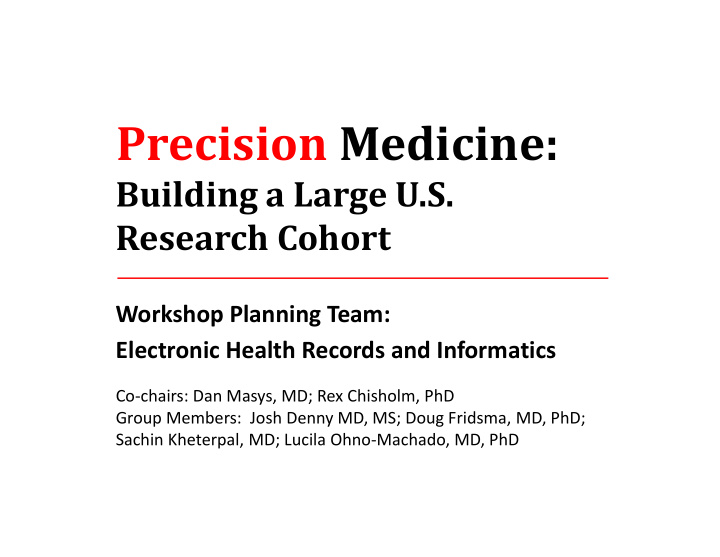



Precision Medicine: Building a Large U.S. Research Cohort Workshop Planning Team: Electronic Health Records and Informatics Co ‐ chairs: Dan Masys, MD; Rex Chisholm, PhD Group Members: Josh Denny MD, MS; Doug Fridsma, MD, PhD; Sachin Kheterpal, MD; Lucila Ohno ‐ Machado, MD, PhD
Current Landscape • Electronic Health Records (EHRs) offer the promise of supporting both discovery science and improved healthcare process and outcome • Strengths Longitudinal (increasingly, lifelong) observations – – Document each individual as ‘an experiment of Nature’ (and experiment of personal choices, environment, health decisions and interventions) – Now past the ‘tipping point’ in adoption: ~100% of hospitals; 85+% outpatient practices – Federal certification process for EHRs includes incentives for interoperability
Challenges and Opportunities 1. Human and business factors: Individual and institutional motivation to participate, and integrated consent management systems 2. Technical issues in integrating and analyzing data from heterogeneous systems 3. Putting patients in control: Enhancing “Blue Button” functionality for research 4. Industry engagement 5. Cybersecurity
Challenge: Human and Business Factors Creating and Articulating a Compelling Value Proposition for participation by Organizations and Individuals • Three pathways for access to clinical data: – Union of existing NIH ‐ sponsored cohorts – New organizational relationships with healthcare entities – Direct submission by individuals in the cohort • Alignment of Incentives – Financial incentives small per participant due to cohort size – Quid pro quo models that recognize value of returned research information to participating organizations and individuals should be considered • Federated vs. centralized models of operation affect willingness to participate • Electronic systems infrastructure for interactive, fine ‐ grained consent is feasible
Challenge: Integrating and Analyzing Data from Heterogeneous Systems • “Research grade” phenotypes can be extracted from routine clinical data in EHR systems • Requires both structured data (billing codes, lab values, medications) and analysis of unstructured text (H&P, procedure and discharge summaries, progress notes, etc.) • Depends critically upon linking data to the correct individual • Data is rich in features that support re ‐ identification of individuals: no technology ‐ only solution to ensuring privacy • Required expertise in Natural Language Processing of clinical text is a scarce resource currently
Opportunity: enhancing “Blue Button” functionality for Research • HIPAA/HITECH gives individuals rights to electronic copies of their EHR data. • ONC “Blue Button” campaign to encourage individuals to exercise this right, and EHR system builders to implement it • Currently there are technical specifications for clinical summaries and insurance benefits. • Vision: a “Synch for Science” (S4S) button that enables an individual to download their clinical data and transmit it to a research data center. • Getting there: work with ONC to add additional data types and formats to Blue Button, and with EHR vendors to implement
Challenge: Industry Engagement • A national scale cohort will depend upon engagement and support from commercial EHR vendors • To date, research has not been a prominent ‘use case’ for EHRs • Industry engagement needs to be based on: – Practical, specific, and certifiable functionality – Leveraging existing government ‐ supported EHR requirements – Create transparent, objective measures of success – Technology ‐ agnostic approaches that do not favor one vendor over another • Industry goals include customer “delighters”, not just $$
Challenge: Cybersecurity • Data for research will arise in part as Protected Health Information (PHI) from HIPAA covered entities: highly sensitive • A national cohort will depend critically upon digital telecommunications via Internet, smartphones, and other network ‐ connected devices • Cyberattacks on healthcare data are increasing and will remain a persistent threat • No novel project ‐ specific data and communications security technologies likely to be needed, but maintenance of state ‐ of ‐ the ‐ art cybersecurity will be essential
Recommend
More recommend